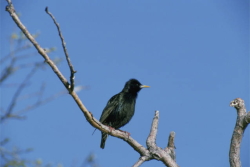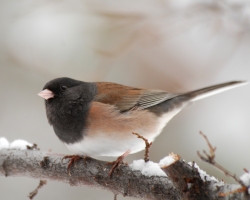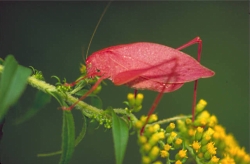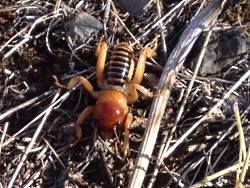
Following many years of demonizing this bird, I have become convinced they do have value beyond compost. In fact, they are utterly fascinating. My first glimmer came when a friend suggested I read “Arnie, the Darling Starling”. I have yet to read it, but he convinced me this bird was worth taking a second look.

Courtesy & © Hilary Shughart, Photographer”
Starlings are commonly kept as pets in Europe and widely used as laboratory animals, second only to pigeons. Austrian ethologist Konrad Lorenz wrote of them in his book King Solomon’s Ring as “the poor man’s dog” and “something to love”. Their inquisitiveness makes them easy to train or study.

Courtesy Wikimedia and Copyright Walter Baxter
Licensed under Creative Commons Attribution-ShareAlike 2.0 license
The starling has 12 subspecies breeding in open habitats across its native range in temperate Europe to western Mongolia, and it has been introduced to seven other countries from Australia to Fiji.
Major declines in populations have occurred from 1980 onward in much of Europe and Eurasia. The decline appears to be caused by intensive farming methods used in northern Europe, and the reduced supply of grassland invertebrates needed for the nestlings. This in contrast to 1949, when so many starlings landed on the clock hands of London’s Big Ben that it stopped the clock!
Our love hate starling relationships are evident in how various countries view them. In Spain, starlings are hunted commercially as a food item. In France, it is classified as a pest, and can be killed throughout most of the year. In Great Britain, Starlings are protected under the Wildlife and Countryside Act. In 2008, the United States government killed 1.7 million starlings, the largest number of any nuisance species to be culled.
A closing note- starlings are trapped for food in some Arab countries. The meat is tough and of low quality, so it is casseroled or made into pâté. Even when correctly prepared, it may still be seen as an acquired taste. You may wish to remove them from your grocery list.
Jack Greene for Bridgerland Audubon Society, and I’m wild about Utah’s not so wild starlings!
Credits:
Pictures: Courtesy US FWS, Dave Menke, Photographer
Pictures: Courtesy US FWS, Lee Karney, Photographer
Pictures: Courtesy Wikimedia and Copyright Walter Baxter, Photographer (Licensed Under Creative Commons Attribution-ShareAlike 2.0 license) https://commons.wikimedia.org/wiki/File:Starling_murmuration.jpg
Audio: Courtesy & © Kevin Colver https://wildstore.wildsanctuary.com/collections/special-collections
Text: Jack Greene, Jack Greene, Bridgerland Audubon Society & Utah State University Sustainability
Additional Links: Lyle Bingham, Webmaster, Bridgerland Audubon Society, Wild About Utah,
Additional Reading:
Grant, Val, Short-tailed Bird of Perdition-Starlings, Wild About Utah, June 5, 2009, https://wildaboututah.org/short-tailed-bird-of-perdition-starlings/
European Starling, Sturnus vulgaris, Julia Butler Hansen Refuge, US Fish and Wildlife Service, US Department of the Interior, https://www.fws.gov/refuge/julia_butler_hansen/wildlife_and_habitat/habitats/birds/european_starling.html
King, Barbara J., Video: Swooping Starlings In Murmuration, National Public Radio (NPR), January 4, 2017 2:29 PM ET, https://www.npr.org/sections/13.7/2017/01/04/506400719/video-swooping-starlings-in-murmuration
European Starling, BirdWeb, https://www.birdweb.org/birdweb/bird/european_starling
Sigl Corbo, Margarete(Author), Barras, Diane Marie(Author), Morrill, Leslie(Illustrator), Arnie, the Darling Starling, Houghton Mifflin Harcourt, November 1, 1983, https://www.amazon.com/Arnie-Darling-Starling-Margarete-Corbo/dp/0395343909





